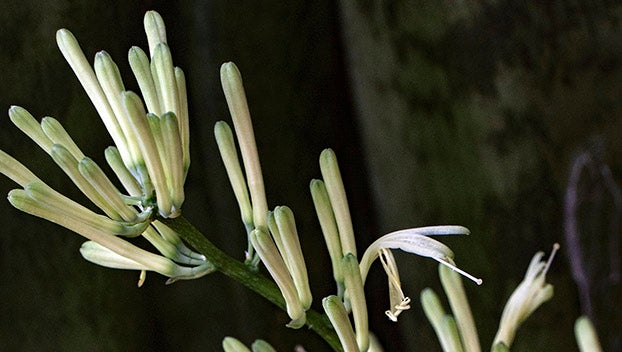Through the Garden Gate: Behold the Snake Plant
Published 10:25 am Saturday, November 11, 2023

- Snake plants produce spikes of creamy white, fragrant flowers that last for several weeks.
|
Getting your Trinity Audio player ready...
|
Many years ago, everyone’s front parlor had one. It sat in a dark corner in that cold, seldom-used room where it was definitely out of sight and out of mind. Dust collected on its leaves. The soil in its container was ancient and probably devoid of nutrients. The poor thing was seldom watered and yet it clung to life, not thriving, but not dying either. What was it? The snake plant or mother-in-law’s tongue (Dracaena trifasciata; formerly Sansevieria trifasciata).
I had forgotten about the snake plant until this summer when I saw a tall, glossy one by my neighbor’s front door. And it was blooming! She casually remarked that she’d had it for ages and that it bloomed every summer. She simply kept it inside during winter and, then in late spring, repotted half the plant in fresh soil and put it outside by the front door. Simple.
Who knew that the snake plant bloomed! Since then, I’ve learned that the snake plant is the trendy new house plant that’s purported to improve the feng shui of a room and even to work as an air purifier. According to NASA, the previously much maligned snake plant can remove various toxic chemicals, such as formaldehyde, benzene, xylene, and trichloroethylene, from the air. Using Crassulacean Acid Metabolism, a special type of photosynthesis, the snake plant also continues to take in carbon dioxide and emit oxygen at night. Only a few other plants do this.
As our grandmas knew, the snake plant is easy to grow. Plant it in soil that drains readily and use a sturdy container that won’t tip over easily. Water the plant weekly from spring until early winter, just be sure that water doesn’t collect in the saucer under the plant. From winter until spring, water monthly. Although the snake plant isn’t a heavy feeder, it benefits from a monthly application of all-purpose fertilizer for house plants during its growing season. The leaves should be periodically dusted or wiped with a damp cloth.
The snake plant grows best in bright, indirect light. Too much bright sunlight will scorch the leaves; too little sun, and the plant won’t thrive. Large, straight species snake plants (the ones most people have) can be placed outside in a shady location during late spring and summer. Time outdoors seems to encourage flowering.
No space for a large snake plant? There are cultivars available in new color patterns and smaller sizes. The Moonglow cultivar has broad, silver-green leaves with dark green bands. Bantel’s Sensation has vertical white stripes and narrow leaves. Hahnii Black Star, Black Gold, Ocean Star, and Lotus are all dwarf snake plants that produce a rosette of leaves.
Afraid to grow houseplants? Try a snake plant. Remember, you have to work hard to kill one.
Dr. Cynthia Wood is a master gardener. Her email address is cynthia.crewe23930@gmail.com.




